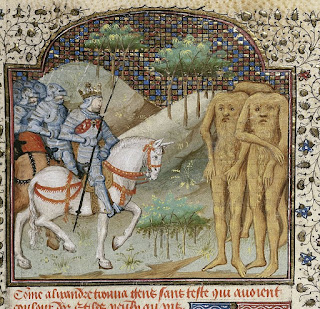We have heard a lot about strange creatures in our world, and at first, I thought they were just stories, but there is a rule that every myth has an origin in history.
Every myth always has a clue or origin in history this is what science shows us now and like we believe that we are not alone in universal sure there are many other strange creatures in our world we don't know about it anything.
Have you ever heard about headless men?
 |
| Blemmyae from cotton paper from British Library |
At first sight, you will think its something strange but let me tell you the whole story about these people and let's take you on tour and go deeper into lost history ......... Are You Ready !!!!!!!!
At begin let us begin our research journey from ancient stories from Arabs History Books :
 |
| Book "Big Animals Life " |
- Headless men ( Blemmyaes) were mentioned by Muhammed Bin Musa Damiri in his Book Big Animals Life and Herodotus in his history, when he was talking about the peoples inhabiting ancient Libya.
- He claimed that these creatures existed in the eastern part of the country along with strange and ugly creatures. Others such as human dogs and savage orangutans.
- There are many references to the existence of these strange nations in the books of Arab and Muslim travelers and geographers. The geographer and the Ottoman scholar ( Muhyi al-Din Ibn Muhammad al-Rayyes ), who died in 962 AH (Islamic year), mentioned in his maps that in South America : (Nations of people have their faces in their chests and they have no heads, and the length of one of them is seven handspans and an inch between his eyes and they are harmless, and other nations have the faces of foxes. and dogs ).
- And the scholar ( Zakaria al-Qazwini ) said in his book “The Wonders of Creatures and the Strangeness of Beings” in the section – Nations of strange shapes – he said – a nation (Minsk) and they are in the direction of the east. A nation in the islands of the sea, their faces are like the faces of dogs and the rest of their bodies are like the bodies of people being nourished by the fruits of trees, and if they find anything of the animals they eat - and from them - a nation that has no head for their bodies, and their mouths and eyes are on their chests.
- Ibn al-Wardi mentioned in the book: “Khuridat al-Ajaa’ib and Farida al-Ghareeb” and said, like what Abu Sheikh al-Asbahani said about it some (Ottoman documents) and indicating the existence of these nations. And he returned to Yemen from their captivity with people whose faces were in their chests, so the people panicked about them, so he was called Dhul-Adhar, and this was during his father's life.
 |
| blemmyae |
Is there any clue about this nation in other mythology?
Yes, there is mention in other mythology :
 |
| The Alexander with his soldiers in front blemmyaes |
- The Letter material was incorporated into the Alexander legend by Leo Archipresbyter, known as Historia de preliis, which was translated into Old French as Roman d'Alexandre en prose. In the prose Alexandre, the golden-colored headless encountered by Alexandre measured just 6 feet tall and had beards reaching their knees. In the French version, Alexander captures 30 of the headless to show the rest of the world, an element lacking in the Latin original.
- And between (1357: 1371) The Travels of Sir John Mandeville writes of "ugly folk without heads, who have eyes in each shoulder" with their mouths "round like a horseshoe, in the middle of their chest" living among the populace in the big island of Dundeya (Andaman Islands) between India and Myanmar.
Another story has been told at Age of Discovery :
- During the Age of Discovery, a rumor of headless men called the Ewaipanoma was reported by Sir Walter Raleigh in his Discovery of Guiana, to have been living on the banks of the Caura River. Of the story, Raleigh was "resolved it is true because every child in the provinces of Aromaia and Canuri affirm the same". He also cited an anonymous Spaniard's sighting of the Ewaipanoma. Joannes de Laet, a somewhat later contemporary, dismissed the story, writing that these natives' heads were set so close to the shoulders that some were led to believe their eyes were attached to the shoulders and the mouth to their breasts.
- During the same period (around 1589–1600), another English writer, Richard Hakluyt, described a voyage by John Lok to Guinea, where he found "people without heads, called Blemines, having their eyes and mouth in their breast.
At The End :
In the end, there are many stories we don't know about it in History and we don't know if it myths or truths and stay come over and over and start to appear to buy time, but what we can say is that History has many hidden things we don't know about it anything.
So what do you think and what are your opinions tell me in the comments ??
Best Wishes Till the Next Story


